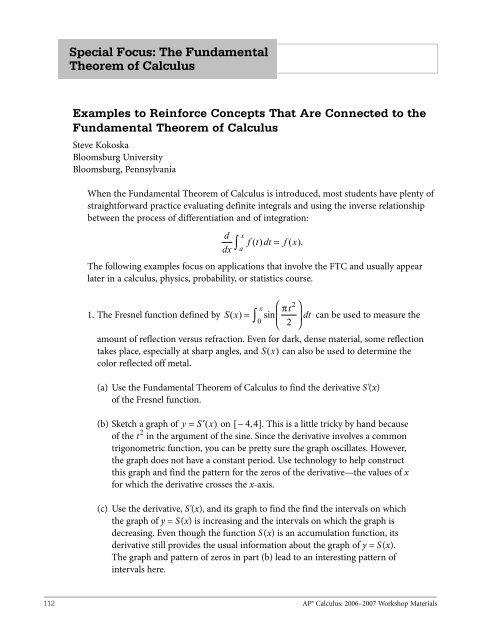AP Calculus
Create successful ePaper yourself
Turn your PDF publications into a flip-book with our unique Google optimized e-Paper software.
Special Focus: The Fundamental<br />
Theorem of <strong>Calculus</strong><br />
Examples to Reinforce Concepts That Are Connected to the<br />
Fundamental Theorem of <strong>Calculus</strong><br />
Steve Kokoska<br />
Bloomsburg University<br />
Bloomsburg, Pennsylvania<br />
When the Fundamental Theorem of <strong>Calculus</strong> is introduced, most students have plenty of<br />
straightforward practice evaluating definite integrals and using the inverse relationship<br />
between the process of differentiation and of integration:<br />
d<br />
dx<br />
x<br />
∫ f ( t) dt = f ( x).<br />
a<br />
The following examples focus on applications that involve the FTC and usually appear<br />
later in a calculus, physics, probability, or statistics course.<br />
x ⎛ πt<br />
⎞<br />
1. The Fresnel function defined by S( x) = ∫<br />
2<br />
sin ⎜ ⎟ dt can be used to measure the<br />
0<br />
⎝ 2 ⎠<br />
amount of reflection versus refraction. Even for dark, dense material, some reflection<br />
takes place, especially at sharp angles, and S( x) can also be used to determine the<br />
color reflected off metal.<br />
(a) Use the Fundamental Theorem of <strong>Calculus</strong> to find the derivative S'(x)<br />
of the Fresnel function.<br />
(b) Sketch a graph of y = S′( x) on [ − 4, 4 ]. This is a little tricky by hand because<br />
of the t 2 in the argument of the sine. Since the derivative involves a common<br />
trigonometric function, you can be pretty sure the graph oscillates. However,<br />
the graph does not have a constant period. Use technology to help construct<br />
this graph and find the pattern for the zeros of the derivative—the values of x<br />
for which the derivative crosses the x-axis.<br />
(c) Use the derivative, S'(x), and its graph to find the find the intervals on which<br />
the graph of y = S(x) is increasing and the intervals on which the graph is<br />
decreasing. Even though the function S(x) is an accumulation function, its<br />
derivative still provides the usual information about the graph of y = S(x).<br />
The graph and pattern of zeros in part (b) lead to an interesting pattern of<br />
intervals here.<br />
112<br />
<strong>AP</strong>® <strong>Calculus</strong>: 2006–2007 Workshop Materials


